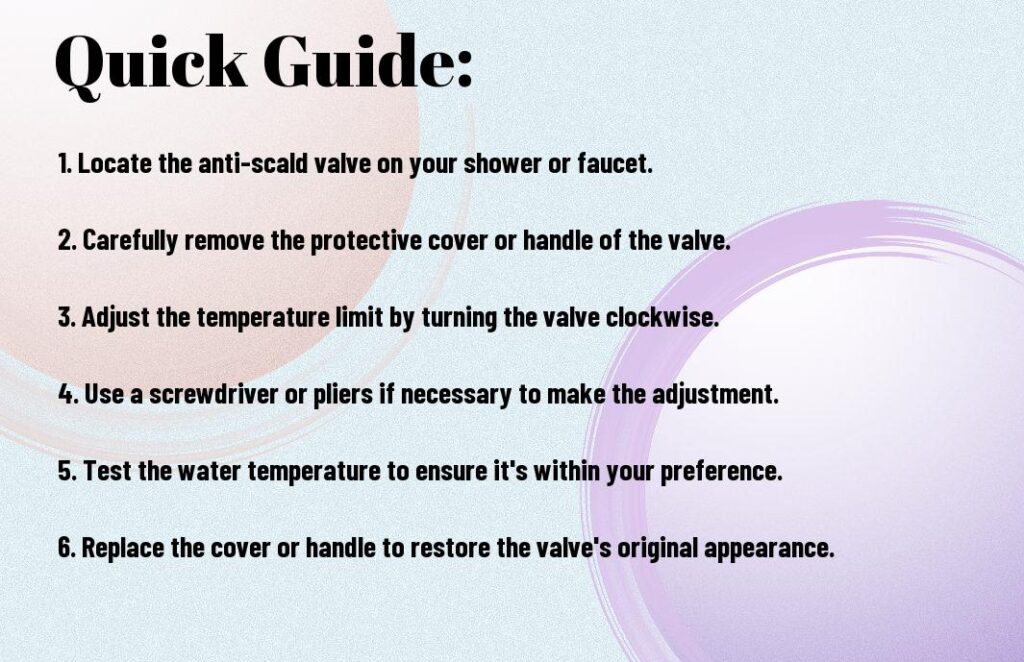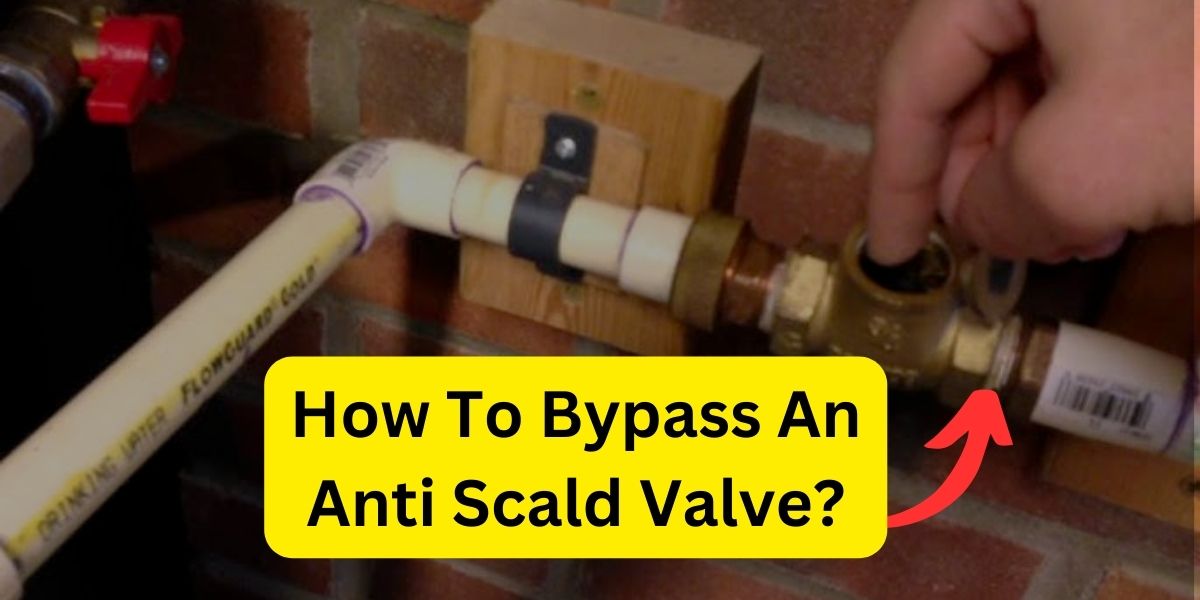How To Bypass An Anti-Scald Valve? A Quick Guide
So, you’re tired of lukewarm showers and you’re ready to take control of your water temperature. Congratulations, you audacious rebel! Today, I’m going to show you how to bypass that suffocating anti scald valve that’s been holding you back.
Now, I must warn you, this method is not for the faint-hearted, it’s a bold move that should only be attempted by those whose thirst for hot water is unquenchable. But fear not, my friend, because with a little ingenuity, you’ll be reveling in the euphoria of steamy showers in no time. Now, let’s dive into the dangerously thrilling world of bypassing an anti scald valve, and unlock the blissfully boiling secret it guards!
Key Takeaways:
Understand the purpose of an anti scald valve: Before attempting to bypass an anti scald valve, it is crucial to comprehend its importance. These valves regulate water temperature to prevent scalding accidents, especially in showers and faucets.
Consult a licensed professional: Bypassing an anti scald valve is not recommended as it can pose safety risks. Instead of attempting it yourself, consult a licensed plumber or professional who can evaluate the situation and provide the proper solution.
Consider alternative solutions: If you encounter issues with an anti scald valve, explore alternative solutions rather than attempting to bypass it. This can involve adjusting the valve’s temperature setting, replacing faulty parts, or seeking professional assistance to ensure proper functioning.
Remember, the safety and well-being of individuals should always be prioritized over any attempts to bypass or alter safety mechanisms.

Here is a video guide:
Types of Anti-Scald Valves
Any homeowner or occupant of a building with hot water plumbing knows the importance of having an anti-scald valve installed. These valves are designed to regulate the water temperature, preventing it from reaching dangerously high levels and minimizing the risk of scalding accidents.
However, it’s essential to understand that not all anti-scald valves are created equal. In this chapter, we will explore the different types of anti-scald valves available on the market to help you make an informed decision.
Types Based on Functionality
When it comes to functionality, anti-scald valves can be categorized into various types. Each type serves a specific purpose and offers unique benefits. Let’s take a closer look:
- Pressure-Balancing Valves: These valves automatically adjust the hot and cold water flow to maintain a consistent water temperature, even if there are fluctuations in the water pressure.
- Thermostatic Valves: These valves use advanced temperature-sensing mechanisms to regulate the water temperature precisely. They are highly effective in preventing scalds by immediately shutting off the hot water if the temperature exceeds a safe level.
- Mixing Valves: Mixing valves combine hot and cold water to create a safe and comfortable temperature for use. They allow you to set a desired water temperature and maintain it throughout your bathing or showering experience.
- Digital Valves: These modern valves feature digital controls that allow you to set and monitor the water temperature digitally. They often come with additional safety features such as timers and automatic shut-off functions.
- Combination Valves: Combination valves integrate different anti-scald functionalities into a single unit, providing comprehensive protection against scalding incidents.
Types Based on Material
Anti-scald valves can also be categorized based on the materials they are made of. The choice of material can affect the valve’s durability, effectiveness, and compatibility with your plumbing system. Consider the following materials:
- Brass Valves: Brass valves are known for their durability and resistance to corrosion. They offer reliable performance and are commonly used in both residential and commercial applications.
- Stainless Steel Valves: Stainless steel valves are highly resistant to rust and can withstand high temperatures, making them ideal for applications where hot water is a primary concern.
- Plastic Valves: Plastic valves are lightweight, affordable, and easy to install. However, they may not be as durable as metal valves and may be prone to wear and tear over time.
- Bronze Valves: Bronze valves are a popular choice due to their excellent heat resistance and longevity. They are often used in high-temperature applications.
- Composite Valves: Composite valves combine different materials to leverage their individual strengths. They are designed for enhanced durability, reliability, and performance.
Remember, when selecting an anti-scald valve for your home or building, take into account both functionality and material. Understanding the different types available will help you choose the one that best suits your needs and ensures a safer bathing and showering experience for you and your loved ones.
Step-by-Step: Bypassing an Anti-Scald Valve
While bypassing an anti-scald valve may not be advisable and can have serious consequences, we understand that you might find yourself in a situation where it’s necessary. Please note that tampering with safety devices is risky and could lead to injury or property damage. If you decide to proceed, it is crucial to take all necessary precautions and consult a professional if unsure.
Preliminary Measures
Before attempting to bypass an anti-scald valve, it’s vital to ensure your safety and protect your surroundings. Begin by gathering the required tools and materials, which may include a wrench, pliers, a bucket, and pipe tape. You want to have these readily available to prevent any delays during the process.
Next, turn off the main water supply to your home. This step is critical to avoid any accidental flooding or damage while working on the valve. Take the time to familiarize yourself with the valve’s location, as it may vary depending on your plumbing setup. Typically, you can find it near the water heater or in the bathroom behind the showering area.
Once you’ve located the valve, take a look at the manufacturer’s manual or do some online research to understand its structure and mechanism. This knowledge will help you navigate through the bypass process and minimize any potential mistakes or mishaps.
The Bypass Procedure
Now that you have taken the necessary preliminary measures, it’s time to move on to the actual bypass procedure. Please remember that while we are providing instructions, we strongly recommend getting professional assistance to guarantee your safety.
Your first step is to remove the protective cover from the anti-scald valve. Use a wrench or pliers to carefully loosen and disconnect the necessary pipes. Make sure to place a bucket beneath the valve to catch any residual water.
Once the pipes are disconnected, you can remove the anti-scald valve from its current position. Take caution while doing so, as the valve may be attached firmly and require a bit of force. Use your toolbox to secure the valve and avoid any damage to the surrounding pipes.
With the anti-scald valve removed, proceed to install a bypass loop. This loop will act as an alternative route for the water, avoiding the temperature control function provided by the anti-scald valve. Use pipe tape to secure the joints and connections, ensuring a tight and leak-free installation.
After the bypass loop is securely in place, it’s time to reconnect the pipes and turn the main water supply back on. Double-check all the connections for any leaks or loose fittings. If everything seems secure, your temporary bypass solution may now be operational.
It’s important to note that bypassing an anti-scald valve should only be considered as a temporary measure. While this procedure might solve immediate issues, it doesn’t address the underlying problem or provide long-term safety. We highly recommend consulting a professional plumber who can assess and address the valve’s malfunction.
Remember, the safety of you and your loved ones should always come first. Although bypassing an anti-scald valve might seem like a quick fix, it’s crucial to prioritize your well-being and seek expert guidance to ensure a proper and permanent solution.
Essential Tips for Bypassing an Anti-Scald Valve
When approaching the task of bypassing an anti-scald valve, it’s crucial to adhere to the following tips:
- Take safety precautions: Before beginning the bypass procedure, make sure to turn off the water supply and release any pressure in the system. This will minimize the risk of injury and ensure a smoother process.
- Plan ahead: Map out the steps involved in the bypass procedure before you start. Having a clear plan in place will save you time and help prevent any potential mishaps along the way.
- Use the right tools: Ensure that you have the necessary tools and equipment on hand before you begin. This includes proper wrenches, pliers, and any other specialized tools necessary for accessing and bypassing the valve.
- Consult the manufacturer’s instructions: Familiarize yourself with the specific instructions provided by the manufacturer of your anti-scald valve. Adhering to their guidelines will help you understand the inner workings of the valve and ensure a proper bypass process.
- Test the water temperature: After bypassing the anti-scald valve, it is crucial to check the water temperature to ensure it falls within a safe range. Nobody wants to experience scalding or freezing water due to an improperly adjusted bypass.
Remember: While bypassing an anti-scald valve may seem like a simple task, it is essential to prioritize safety and accuracy throughout the process. Keep these tips and factors in mind as you embark on bypassing the valve, and consult professionals if you encounter any concerns or uncertainties. Your efforts will ultimately result in a more personalized and enjoyable bathing experience.
Conclusion
So, now you know the ins and outs of bypassing an anti-scald valve. Remember, this information is not meant to encourage or condone any illegal or unethical activities. It is crucial to prioritize safety and follow the regulations put in place to protect you and your loved ones.
If you are experiencing issues with the temperature of your water, it is always best to consult a professional plumber who can provide the appropriate solutions and ensure the well-being of everyone in your household. Stay informed, stay curious, and always make safety your number one concern.
FAQ
Q: What is an anti-scald valve and why would I want to bypass it?
A: An anti-scald valve is a device installed in plumbing systems to prevent water from reaching dangerously hot temperatures. While it’s designed to protect you from scalding accidents, there may be situations where you need to bypass it. Maybe you’re a rebel who enjoys a steamy shower, or perhaps you’re trying to troubleshoot a problem with the valve itself. Whatever the reason, we’ve got you covered!
Q: Can I bypass an anti-scald valve myself, or should I call a professional plumber?
A: Well, my friend, that depends on your level of DIY confidence and expertise. If you’re a handy wizard with pipes and plumbing, go ahead and give it a shot. But, and this is a big but, if you’re more of a “Pinterest fail” kind of person, it’s best to call in the professionals. Messing around with your plumbing system without proper knowledge can lead to leaks, floods, and a whole lot of headaches. So, unless you have the skills to pay the plumbing bills, leave it to the pros.
Q: Okay, I’m feeling brave. How do I bypass an anti-scald valve?
A: You courageous soul! Here’s a step-by-step guide to help you navigate through the treacherous waters of bypassing an anti-scald valve:
- Find the main water supply valve and shut it off – safety first, my friend!
- Locate the anti-scald valve. It’s usually located in your shower or near the water heater.
- Remove any decorative covers or handles obscuring the valve.
- Inspect the valve to identify the bypass mechanism, which may be a simple lever or a temperature adjustment knob.
- Engage the bypass mechanism, effectively disabling the anti-scald feature. This might involve turning the knob counterclockwise or flipping the lever.
- Replace any covers or handles you removed earlier, because we like things looking pretty.
- Turn the main water supply valve back on and test the water temperature to ensure it meets your perfectly steamy standards.
- And voila! You have successfully bypassed the anti-scald valve and reclaimed control over your water temperature destiny.
Remember, tinkering with your plumbing is not for the faint of heart. If at any point during this process you feel unsure or overwhelmed, don’t hesitate to call in a professional plumber. It’s better to be safe than sorry, my friend!

William J. Bullock is a licensed plumber with over 15 years of experience installing and repairing bathtubs. He runs his own plumbing company in Greenville and serves residential and commercial clients. William is dedicated to providing honest, transparent advice to help homeowners make informed decisions about their bathroom renovations.
He has established expertise in selecting bathtubs, planning custom installations, diagnosing issues, and completing repairs. William aims to share practical tips and reliable recommendations based on extensive hands-on work. When he isn’t on a job site, William enjoys spending time with his family and volunteering at local community events. He takes pride in delivering quality service and enjoys helping people upgrade their homes.







